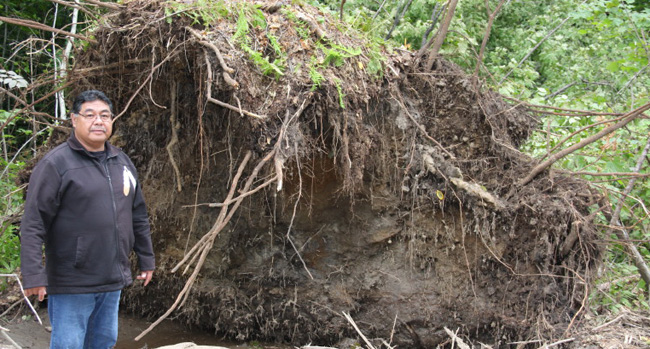‘Possible’ tornado on Christian Island

By Sharon Weatherall
BEAUSOLEIL FIRST NATION – Christian Island members are still cleaning up downed trees and debris following a wicked storm that hit the community last Friday afternoon. It was one of two that caused severe damages and flooding that day, leaving residents without hydro from Friday afternoon until Saturday at 5 p.m. Remarkably no one was hurt.
“I have never seen a storm like that in all the time I have lived here,” said Beausoleil First Nation Chief Roland Monague describing the high winds that left rows of trees uprooted and broken off laying in all directions across roadways, on roofs and properties.
“It was a quick storm with so much damage. We have had tornadoes touch down all around us but this is the first time something hit us that bad. People commented that they heard what sounded like a freight train or a low flying jet.”
Speaking with Peter Kimbell – warning preparedness meteorologist, he says a “tornado is certainly possible” on Christian Island. Close by the in the City of Orillia, a downburst was sighted that turned into a tornado and a tornado was also sighted east of Orillia.
“A tornado cannot be ruled out on Christian Island but it’s too early to make that conclusion yet. Based on the damage we are still investigating,” said Kimbell.
When the storm hit, a funnel cloud was sighted by two workers on the island who scrambled for cover. Later two paths of downed trees were discovered in the woods along the Big Sand Bay Road, leaving trees strewn across the road for some distance. Monague believes there could have been two funnel clouds touch down due to the severe damage on both sides of the road and the way the trees were laying in every direction.
In the heart of the community students were on lockdown in the school after downed trees and hydro lines covered streets in the community. One tree landed on a fence behind the Social Services building just missing several large propane tanks which could have caused an explosion, while another fallen tree took out a window in the building.
Weather networks had called for two storms that day – the first one was around 2 p.m. Three hours later the second storm hit with torrential downpours leaving whole roads flooded out and impassible with water hip deep in some instances. Across the bay at Cedar Point there were also damages and flooding to homes on that part of the reserve. Monague says during the storm winds prevailing from the north bringing rain and large hail, abruptly changed to the south west.
“People were scared when the second storm hit around 5 p.m. and took shelter in their basements,” said Monague.
“On Friday when we called Environment Canada they said it was not a tornado and did not come out but we had calls from CTV News and sent pictures of the damages out to them. Public Works worked all night and the next day cleaning up trees off the roads. Some cottagers were stranded when the roads were washed out.”
Monague says there was speculation the severe damages could have been caused by a microburst – when clouds come too close to the earth creating strong winds. But judging by the damage patterns and intensity of the storm he thinks that huge trees were uprooted and tossed across the roads by tornado force winds.
Monague says there is no estimate of damages as yet as public works are still trying to tally up the costs. BFN will approach Indian and Northern Affairs Canada (INAC) for funding when they have an accurate estimate.


